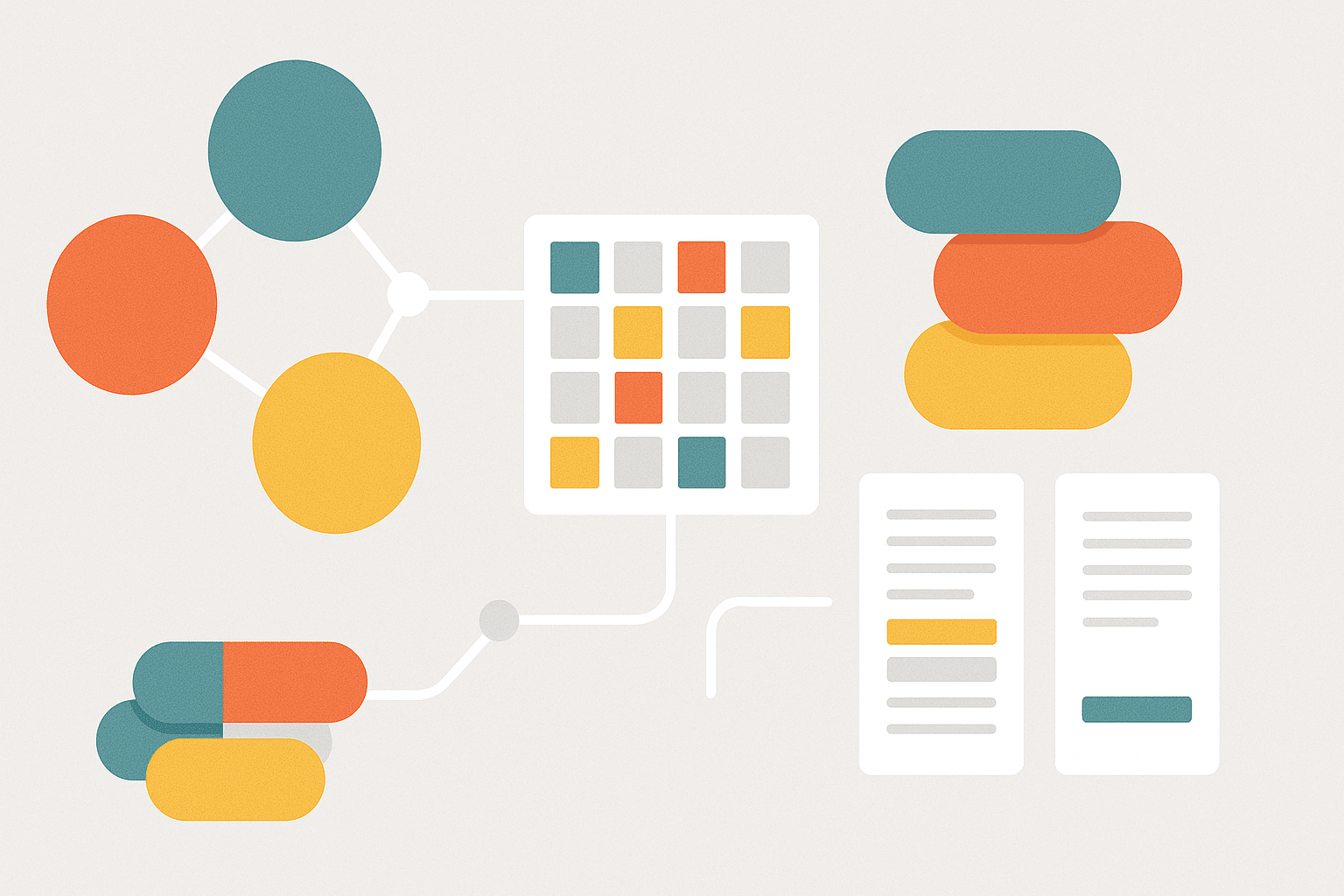Topic modeling is an unsupervised machine learning method used in natural language processing to find hidden topics inside large sets of text. It works by detecting frequently co-occurring words and grouping them into clusters that form meaningful themes. Each topic is a group of related terms that usually appear together. For example, a football-related topic may include words like goal, Manchester United, Chelsea, and soccer.
This technique treats documents as bag-of-words, ignoring grammar or word order, and looks for latent patterns in how words are used. It builds probability distributions over words to define topics and shows how each document may contain a mixture of topics in different amounts. The output helps summarize large text collections by highlighting the most common ideas.
Although designed for text, topic modeling is also used in fields like genomics, image analysis, and network science, where similar hidden patterns can be uncovered.
History and development of topic modeling
Topic modeling grew out of early work in information retrieval and evolved into a family of machine learning techniques. It started with simple matrix-based methods and advanced into probabilistic models with strong theoretical structure and practical flexibility.
Early methods and probabilistic foundations
In the late 1980s, latent semantic analysis (LSA) introduced a way to uncover latent patterns in text using singular value decomposition, a linear algebra method. This method worked on a document-term matrix, showing how word co-occurrence patterns could reveal hidden concepts.
This idea led to more formal probabilistic models. In 1998, latent semantic indexing was described using mathematical foundations. Then, in 1999, probabilistic latent semantic analysis (PLSA) was proposed by Thomas Hofmann. PLSA represented each document as a mixture of topics, but it did not include a way to generate new documents.
The major shift came with latent Dirichlet allocation (LDA), introduced in 2002 by David Blei, Andrew Ng, and Michael Jordan. LDA added Dirichlet priors to manage both document-topic and topic-word distributions. These priors made the model more robust and matched real-world language use, where a document usually covers a few topics with a narrow vocabulary.
Model extensions and alternative approaches
Following LDA, several models expanded the core idea:
- Correlated topic model: allowed topics to be statistically linked
- Pachinko allocation model: introduced a hierarchical structure for complex topic relations
- Hierarchical Dirichlet process: removed the need to choose a fixed number of topics in advance
As topic modeling gained popularity, researchers improved inference techniques like:
- Variational expectation-maximization
- Gibbs sampling
These made training faster and more accurate.
In 2012, non-negative matrix factorization (NMF) became another key method. It used a parts-based, additive breakdown of the matrix, forming topics as non-negative word combinations. Unlike probabilistic models, NMF gave an interpretable structure and allowed topic overlap.
Later developments added even more precision. Algorithms like:
- Anchor word methods
- Method of moments
helped recover topic structures using linear algebra and probability, with guarantees under certain conditions.
By the mid-2010s, topic modeling had grown into a flexible, widely used field. Despite the many methods, the goal remained clear: to automatically find hidden topics in large text collections.
Algorithms and modern approaches in topic modeling

Topic modeling algorithms have developed across three main directions: probabilistic models, linear algebra methods, and neural network approaches. Each offers different ways to find hidden themes in large text collections, while keeping the core idea of learning latent topics.
Probabilistic topic models
The most widely used group of algorithms is based on probabilistic generative models. At the center is latent Dirichlet allocation (LDA), where each document is seen as a mixture of latent topics, and each topic is a distribution over words. The model is trained through statistical inference methods to fit the observed text.
Many LDA variants improve topic modeling for specific needs:
- Correlated topic models allow topics to co-occur with dependence
- Dynamic topic models track how topics change over time
- Author-topic models link topics to document authors
- Hierarchical topic models build topic trees where topics form layers of meaning
These models rely on approximate inference algorithms like variational Bayes and Markov chain Monte Carlo sampling, since exact inference is not practical.
Linear algebra and factorization methods
Some algorithms skip probabilistic frameworks and instead use matrix factorization to uncover topics.
- Latent semantic analysis (LSA) uses singular value decomposition (SVD) to reduce dimensionality and discover latent structures
- Weighted inputs like TF–IDF improve LSA by adjusting for common or rare words
- Non-negative matrix factorization (NMF) limits word weights to non-negative values, making topic interpretation simpler
These algebra-based models do not build a full generative story but perform well in practice, supported by fast linear algebra routines. Methods like anchor word techniques and the method of moments also use algebra and probability to recover topics with theoretical performance guarantees.
Neural and embedding-based approaches
In recent years, neural topic models have extended topic modeling with deep learning.
- Autoencoder-style models and variational inference help generate topics from neural embeddings
- For example, neural variational topic modeling improves inference speed and supports flexible priors
More recent work uses contextual embeddings from language models like BERT. These embeddings add word context, solving a known issue in bag-of-words models where word order is lost.
Benefits of embedding-based methods:
- Topics become more coherent, with fewer unrelated words
- Cluster-based models in embedding space improve alignment with human understanding
- Some models fine-tune transformers to output topic distributions directly
There are also approaches using network analysis, such as stochastic block models, to find word communities that act like topics. In the early 2020s, researchers began testing large language models for topic extraction and refinement, combining classic topic modeling with new deep learning tools. These models continue to shape the future of the field.
Applications of topic modeling
Topic modeling is widely used to explore and organize large collections of unstructured text. Its ability to reduce text into interpretable themes helps researchers, analysts, and businesses find useful patterns across various domains.
Academic and research uses
In the humanities and social sciences, topic models help analyze archives like:
- Literary collections
- Newspapers
- Historical records
For instance, historians have used topic modeling to trace changes in public discourse during the American Civil War, using newspaper data from the 19th century. In digital humanities, the technique has been applied to novels and journals to study cultural and language shifts over time.
In library science and bibliometrics, researchers use topic modeling to find research trends in large sets of academic articles. It helps in grouping studies by theme without manual tagging.
Industry and business applications
In the technology and business sector, topic modeling is applied to:
- Customer reviews
- Open-ended survey responses
- Support tickets
- Social media posts
These models identify what features or complaints customers mention most. Businesses use this information to improve products, services, and customer experience strategies. In market research, it helps group free-text answers or forum discussions into major topics.
In brand monitoring and social media analysis, topic modeling tracks emerging trends or detects hate speech and misinformation in large content streams.
Science, health, and data analysis
In bioinformatics and medicine, topic modeling is used to analyze:
- Clinical reports
- Biomedical literature
- Genomic datasets
It helps uncover hidden themes like gene expression groups, biological functions, or disease subtypes. These insights can support diagnostics or research in complex medical fields.
In machine learning and computer vision, the method is adapted for tasks like:
- Image classification
- Pattern detection in time-series data
By converting data into suitable formats, topic models can help label images or identify recurring signals.
Software and tools for topic modeling

Many libraries and platforms support topic modeling, making it easier to extract themes from large text collections. These tools range from programming libraries to visual interfaces and offer support for key models like LDA, NMF, and LSA.
Command-line libraries and language-specific packages
MALLET (MAchine Learning for LanguagE Toolkit) is one of the earliest and most widely used tools for LDA. Built in Java, it uses Gibbs sampling for fast and scalable topic modeling. MALLET also supports extended models like hierarchical LDA and the pachinko allocation model, and includes built-in metrics like topic coherence to check topic quality.
In Python, Gensim is a popular library that offers LDA, non-negative matrix factorization, and latent semantic analysis. Its data streaming design allows it to process very large corpora. Gensim is commonly used in research and industry projects due to its flexibility and modular architecture.
Another major Python package, scikit-learn, provides LDA with variational inference and NMF for topic discovery. Though it is a general machine learning library, its text processing tools are well suited for topic modeling. It also offers fine control over hyperparameters such as the number of topics and algorithm choice.
Graphical tools and specialized platforms
For users who prefer not to code, graphical tools make topic modeling accessible. The Topic Modeling Tool is a front-end for MALLET with a simple user interface that requires no programming. Workflow platforms like Orange and KNIME allow users to build custom NLP pipelines by linking blocks visually. Both platforms include built-in topic modeling components.
Specialized frameworks also exist for domain tasks. In biomedical text mining, for example, prebuilt modules help apply topic models to clinical or scientific documents. These setups are often tailored to support domain-specific preprocessing and vocabulary.
Most modern tools come with built-in support for basic text preprocessing such as tokenization, stopword removal, and cleaning. This streamlines the workflow and makes it easier for beginners and experts to apply topic modeling across fields.
Evaluation and challenges in topic modeling
Topic modeling is useful for summarizing text, but it faces several practical and theoretical challenges. These include setting the number of topics, measuring quality, interpreting results, and handling short or ambiguous text data.
Choosing the number of topics
Most topic modeling algorithms need a fixed number of topics to start. If this number is too low, the topics become too broad. If too high, they become too narrow or overlap. There is no automatic rule for choosing this number, but researchers often use topic coherence to guide the selection.
Topic coherence scores show how closely related the top words in a topic are. Higher coherence usually means the topic is more readable and makes more sense to people. Some scoring methods compare word co-occurrence patterns with reference corpora. Automatic tools like the method proposed by Newman et al. (2010) are now widely used to compare models and tune topic counts.
Interpretability and semantic clarity
Each topic is a set of top words, but these words do not come with a label. Human experts must often look at the terms and decide what the topic means. Sometimes, the words may not point clearly to a single idea, especially if topics overlap or the model splits themes in unexpected ways.
Efforts to improve topic interpretability include:
- Guided topic modeling, where seed words help steer topics
- Topic merging or splitting, based on semantic cohesion
- Using contextual embeddings to add meaning and reduce ambiguity
These methods help deal with polysemous words and improve the model’s ability to reflect real-world meanings.
Modeling assumptions and short text issues
Classic topic models follow the bag-of-words assumption, which ignores grammar and word order. This leads to errors when a word has multiple meanings. For example, the word “bank” could refer to a riverbank or a financial institution. Without context, the model treats them as the same.
To address this, modern techniques use contextual word embeddings from large language models. These embeddings improve the model’s understanding of word sense by using nearby words to guide interpretation.
Another issue is that topic models perform poorly on short texts like tweets or search queries. These texts lack the volume of word co-occurrence needed for strong topic signals. Specialized methods such as biterm topic models have been proposed to better handle these cases.
Evaluating topic quality
Evaluating a topic model is still partly subjective. In addition to coherence scores, other evaluation methods include:
- Testing how well topics help with document classification or information retrieval
- Asking domain experts if the topics are meaningful
There is usually no ground truth for topics, so most evaluations rely on a mix of automated scores and human judgment.
References
- https://www.ibm.com/think/topics/topic-modeling
- https://www.qualtrics.com/experience-management/research/topic-modeling/
- https://en.wikipedia.org/wiki/Topic_model
- https://mallet.cs.umass.edu/index.php/Main_Page
- https://aclanthology.org/2021.acl-short.96/
- https://programminghistorian.org/en/lessons/topic-modeling-and-mallet


